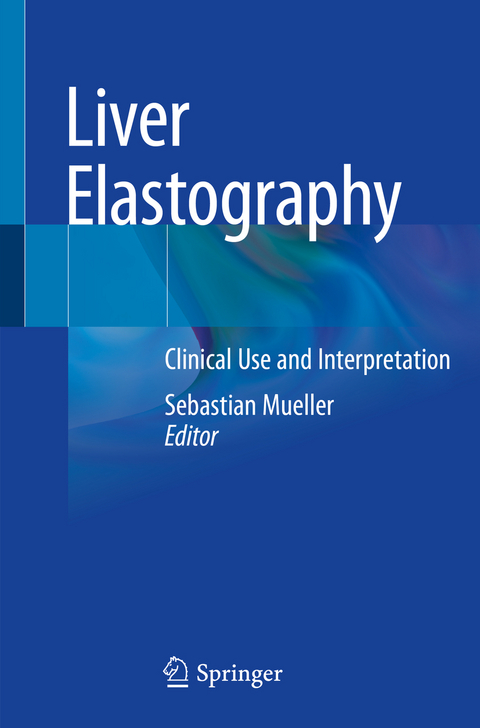
Liver Elastography
Springer International Publishing (Verlag)
978-3-030-40544-1 (ISBN)
This is the first comprehensive book on the new elastographic techniques discussing the early assessment of liver fibrosis. The book covers all aspects of measuring liver stiffness starting from the methodology, the molecular basis of liver stiffness elevation up to current clinical algorithms and interpretation. Future directions and novel implications that go beyond diagnosis but are relevant for understanding of liver cirrhosis per se are also discussed in detail.
Liver Elastography, is an essential companion for hepatologists and gastroenterologists that provides an overview of its basic principles and gives a detailed account of how to use elastrography in clinical practice.
lt;b>Sebastian Mueller is Professor of Medicine and the current vice head of the Department of Internal Medicine at Salem Medical Center and the Co-Director of the Center for Alcohol Research at the University of Heidelberg. He studied medicine in Leipzig, Denver and Strasbourg and obtained a PhD in Biophysics in 1994. He was gastroenterology resident and consultant in Heidelberg, postdoctoral Humboldt fellow at USC in Los Angeles and lecturer at the BIDMC/Harvard Medical School from 2005-2007. Prof. Mueller's translational research includes the pathophysiology, genetics, diagnosis and treatment of liver diseases, namely alcoholic liver disease. His longterm basic research interests focus on hepatic iron metabolism and redox regulation. Prof. Mueller has published more than 100 original articles. Since 2017, he is president of the European Society of Biomedical Research on Alcoholism (ESBRA).
Measurement of Liver stiffness - History, techniques, performance .- Transient elastography.- Sampling error.- ARFI and other US-based techniques .- MRE.- Animal studies.- Take home message.- Liver stiffness and its association with fibrosis .- Fibrosis Histology.- Disease etiology.- Take home message.- Important clinical confounders of LS .- CVP heart failure.- Arterial pressure .- Portal pressure.- Cholestasis.- Hydrostatic pressure.- Outflow inflow concept.- Nutrition and alcohol consumption.- position.- Histology correlates ballooning steatosis inflammation.- Genes Rausch.- Else amyloidosis, mastocytosis.- Take home message.- LS and important clinical endpoints.- HCC.- Portal hypertension, bleeding.- Survival.- Disease specific aspects.- LTX.- Hepatic decompensation.- Take home message.- How to use LS in clinical practice: State of the art 2019 .- Standard procedure position, technique, fasting.- Dissection from inflammation: Intervention and inflammation-adapted.- Disease specific algorithms: portal vs lobular vs cholestatic disease.- LS in combinations with spleen stiffness: portal hypertension and bleeding.- Spleen stiffness, techniques, spleen size.- Localization of hepatic disease: lobular, portal versus extrahepatic.- Comparison of various techniques .- Screening of populations .- Combination with serum markers.- Sparing of biopsies.- Take home message.- Future applications of LS.- Cardiololgy cardiac cirrhosis.- Intensive care unit mortality CVP.- Nephrology water retention.- Hematology.- LTX setting waiting list.- Screening in addiction medicine.- Pregnancy.- Therapeutic monitoring of portal pressure lowering drugs.- Other organs.- Specific interpretation in clinical context.- LS and hepatic vs non-hepatic ascites Ascites.- LS changes in cirrhotics.- Mechanic cholestasis.- Clinical cases.- CAP.- Steatosis techniques.- CAP performance.- Genetics .- Molecular insights based on LS.- Pressure hypothesis of liver fibrosis.- Stiffness in vitro.- Extracellular matrix and stiffness Matrix .- Future directions and open questions.- Molecular basics of LS.- Directions of future studies.- Future diagnostic algorithms.
"This book is not aimed at radiology departments but rather at our colleagues in hepatotology and gastroenterology with the aim to offer them a deeper understanding of the role that elastography, in all its iterations, has in the assessment and management of liver disease. The book is very well written and edited ... ." (Colin Griffin, RAD Magazine, May, 2021)
| Erscheinungsdatum | 04.06.2021 |
|---|---|
| Zusatzinfo | XIX, 737 p. 32 illus., 29 illus. in color. |
| Verlagsort | Cham |
| Sprache | englisch |
| Maße | 155 x 235 mm |
| Gewicht | 1145 g |
| Themenwelt | Medizinische Fachgebiete ► Chirurgie ► Viszeralchirurgie |
| Medizinische Fachgebiete ► Innere Medizin ► Hepatologie | |
| Medizin / Pharmazie ► Medizinische Fachgebiete ► Radiologie / Bildgebende Verfahren | |
| Schlagworte | Cirrhosis • hepatology • liver disease • liver fibrosis • liver stiffness • Steatosis |
| ISBN-10 | 3-030-40544-3 / 3030405443 |
| ISBN-13 | 978-3-030-40544-1 / 9783030405441 |
| Zustand | Neuware |
| Informationen gemäß Produktsicherheitsverordnung (GPSR) | |
| Haben Sie eine Frage zum Produkt? |
aus dem Bereich


